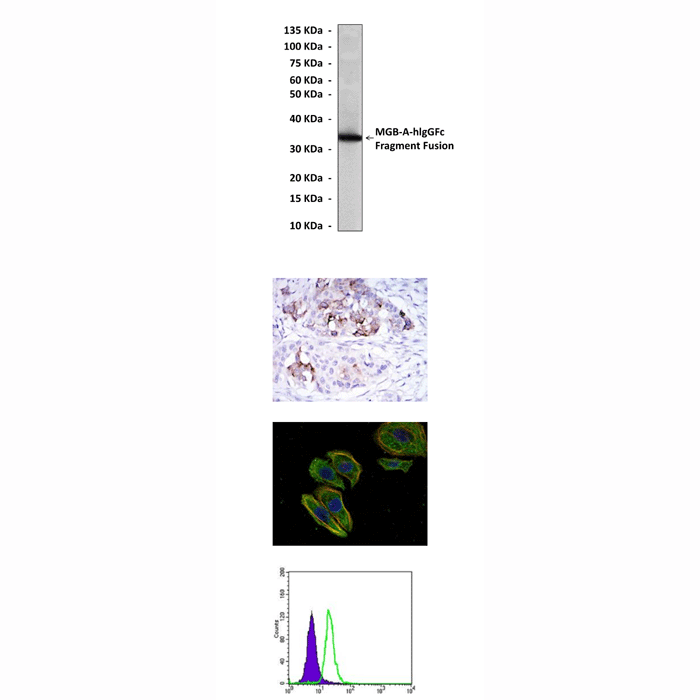Anti-Mammaglobin A/MGB1: Mouse Mammaglobin A/MGB1 Antibody |
 |
BACKGROUND Mammaglobin A (secretoglobin, family 2A, member 2 – SCGB2A2, or mammaglobin-1) is a member of the secretoglobin superfamily, a group of small, secretory, rarely glycosylated, dimeric proteins, mainly expressed in mucosal tissues. The rabbit uteroglobin is the founder member of this family of mammalian proteins, which has expanded to more than 25 members in recent years, currently including nine human secretoglobins. Mammaglobin A, lipophilin B, and most of the human secretoglobins are localized on chromosome 11q13, where they form a dense cluster.1
The mammaglobin A gene (SCGB2A2) encodes a 93-amino acid protein with a predicted molecular mass of 10.5 kDa. In breast tissue it exists in two main forms with approximate molecular masses of 18 and 25 kDa, due to posttranslational modifications. Mammaglobin A is considered to be a highly specific breast tissue marker; initially it was found to be overexpressed in breast cancer, and its expression was restricted to normal and malignant breast tissue. Mammaglobin A was detected immunologically or by RT-PCR in 70 to 100% of the primary and metastatic breast cancer samples examined and in normal breast, but no other normal tissues. Moreover, over 10-fold higher levels of expression were detected by Northern analysis of tumor RNA than by that of patient-matched normal breast RNA. Numerous studies have demonstrated that mammaglobin A is the most specific marker for breast cancer currently available at both the protein and the RNA level.2 No gene amplification or gene rearrangement was detected in tumors overexpressing mammaglobin A, suggesting changes in transcriptional regulation as the cause of overexpression.3 In contrast to other members of the secretoglobin family, its expression does not appear to be influenced by steroid hormones. Due to its tissue specificity, mammaglobin A has drawn much attention. Various studies have evaluated its role in detection of minimal residual disease in breast cancer patients, while others investigated its role as a diagnostic and prognostic marker, and its potential use as a therapeutic target. However, some studies have shown that it is also expressed in tissues other than the breast.4 In breast cancer mammaglobin A is overexpressed in a high proportion of primary tumors, and it is associated with estrogen receptor positive tumors, a less aggressive tumor phenotype, and relapse-free survival.
The mammaglobin A gene (SCGB2A2) encodes a 93-amino acid protein with a predicted molecular mass of 10.5 kDa. In breast tissue it exists in two main forms with approximate molecular masses of 18 and 25 kDa, due to posttranslational modifications. Mammaglobin A is considered to be a highly specific breast tissue marker; initially it was found to be overexpressed in breast cancer, and its expression was restricted to normal and malignant breast tissue. Mammaglobin A was detected immunologically or by RT-PCR in 70 to 100% of the primary and metastatic breast cancer samples examined and in normal breast, but no other normal tissues. Moreover, over 10-fold higher levels of expression were detected by Northern analysis of tumor RNA than by that of patient-matched normal breast RNA. Numerous studies have demonstrated that mammaglobin A is the most specific marker for breast cancer currently available at both the protein and the RNA level.2 No gene amplification or gene rearrangement was detected in tumors overexpressing mammaglobin A, suggesting changes in transcriptional regulation as the cause of overexpression.3 In contrast to other members of the secretoglobin family, its expression does not appear to be influenced by steroid hormones. Due to its tissue specificity, mammaglobin A has drawn much attention. Various studies have evaluated its role in detection of minimal residual disease in breast cancer patients, while others investigated its role as a diagnostic and prognostic marker, and its potential use as a therapeutic target. However, some studies have shown that it is also expressed in tissues other than the breast.4 In breast cancer mammaglobin A is overexpressed in a high proportion of primary tumors, and it is associated with estrogen receptor positive tumors, a less aggressive tumor phenotype, and relapse-free survival.
REFERENCES
1. Watson, M.A. & Fleming, T.P.: Cancer Res. 56:860-5, 1996
2. O'Brien, N.A. et al: Int. J. Cancer 114:623-7, 2005
3. Roncella, S. et al: J. Exp. Clin. Cancer Res. 25:65-72, 2006
4. Guan, X-F. et al: Endocrine 21:245-50, 2003
2. O'Brien, N.A. et al: Int. J. Cancer 114:623-7, 2005
3. Roncella, S. et al: J. Exp. Clin. Cancer Res. 25:65-72, 2006
4. Guan, X-F. et al: Endocrine 21:245-50, 2003
Products are for research use only. They are not intended for human, animal, or diagnostic applications.
Параметры
Cat.No.: | CP10278 |
Antigen: | Raised against recombinant human Mammaglobin A fragments expressed in E. coli. |
Isotype: | Mouse IgG1 |
Species & predicted species cross- reactivity ( ): | Human |
Applications & Suggested starting dilutions:* | WB 1:1000 IP 1:50 IHC 1:50 - 1:200 ICC 1:50 - 1:200 FACS 1:50 - 1:200 |
Predicted Molecular Weight of protein: | 18, 25 kDa |
Specificity/Sensitivity: | Detects endogenous Mammaglobin A proteins without cross-reactivity with other family members. |
Storage: | Store at -20°C, 4°C for frequent use. Avoid repeated freeze-thaw cycles. |
*Optimal working dilutions must be determined by end user.
Документы
Информация представлена исключительно в ознакомительных целях и ни при каких условиях не является публичной офертой








